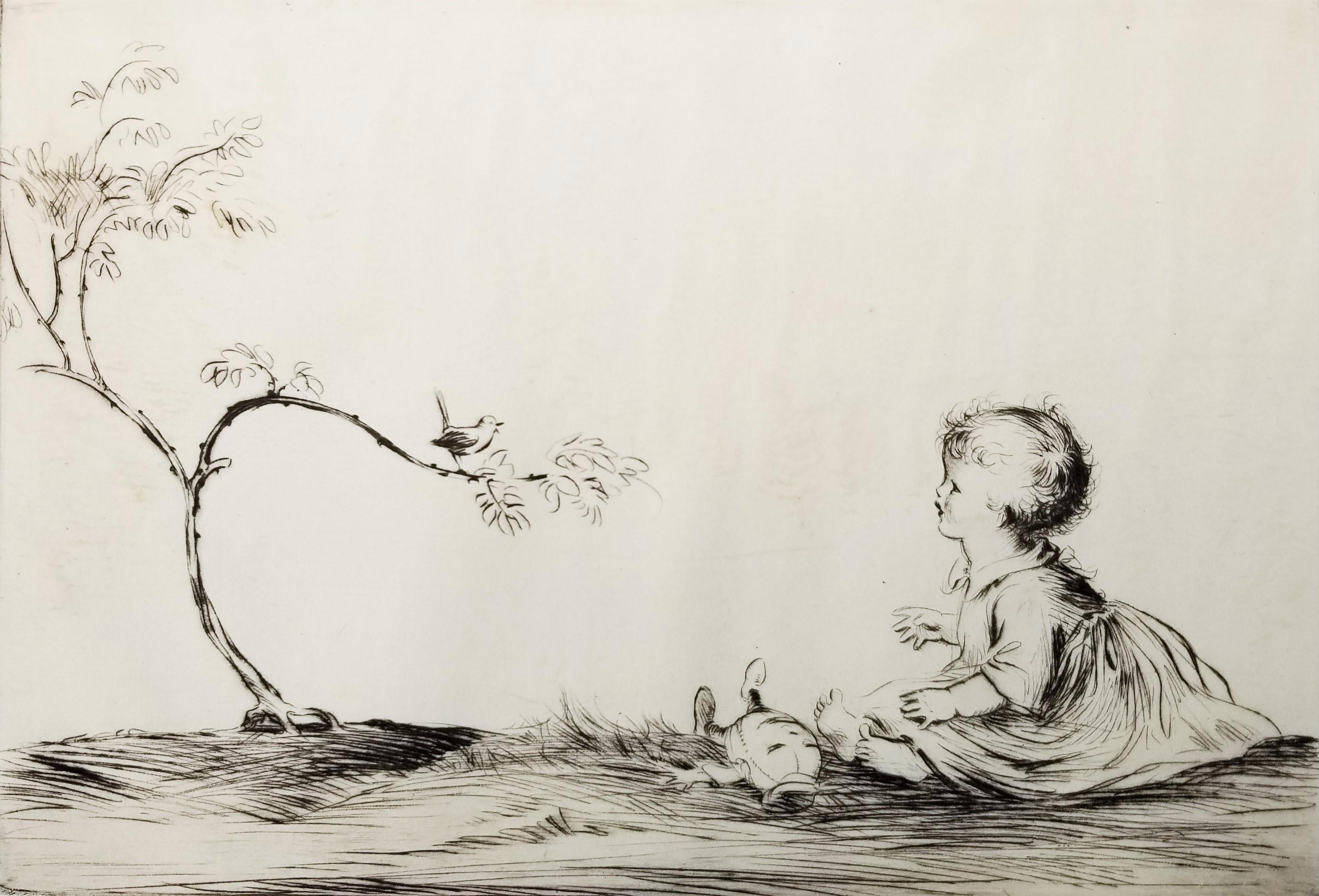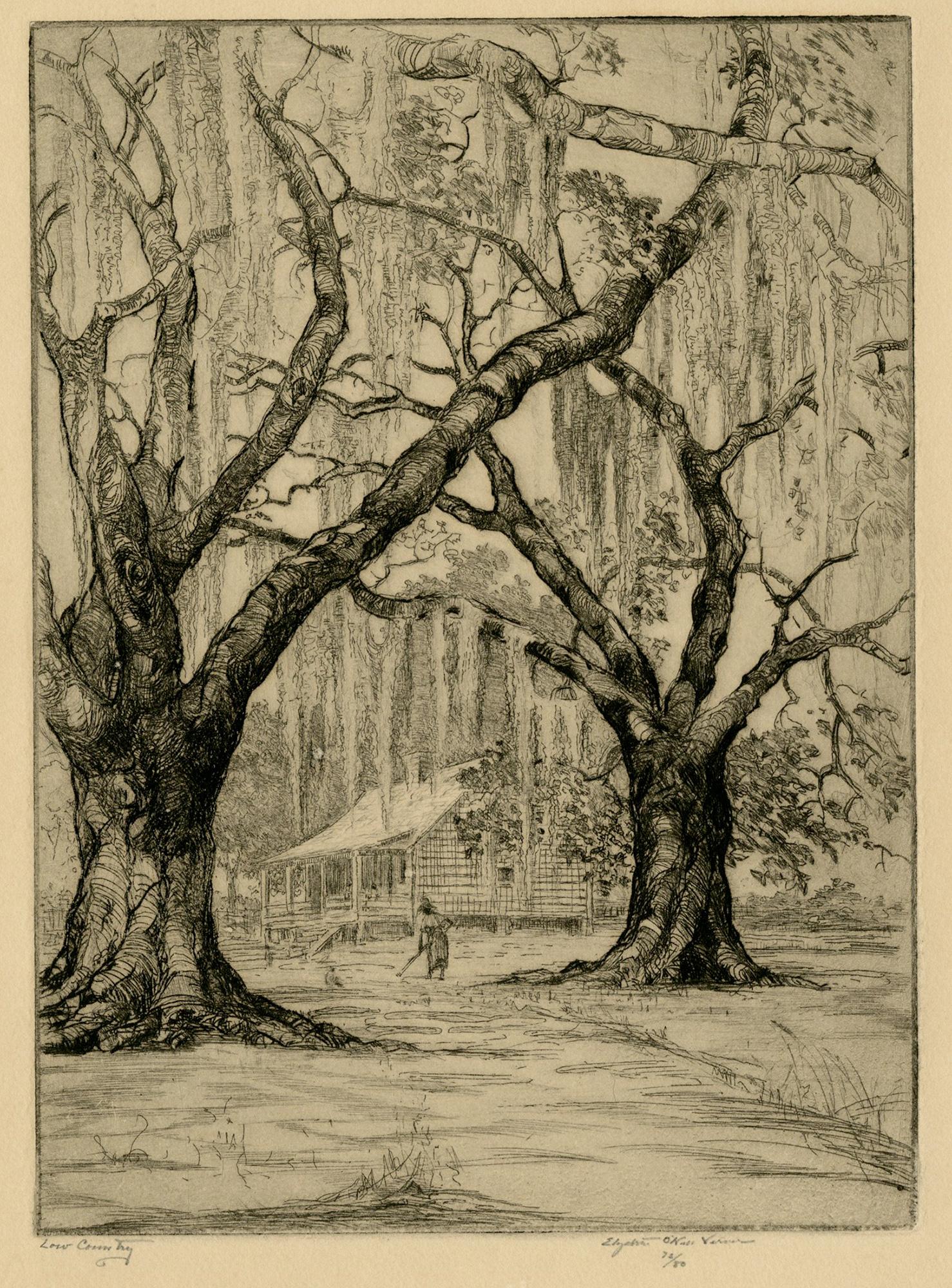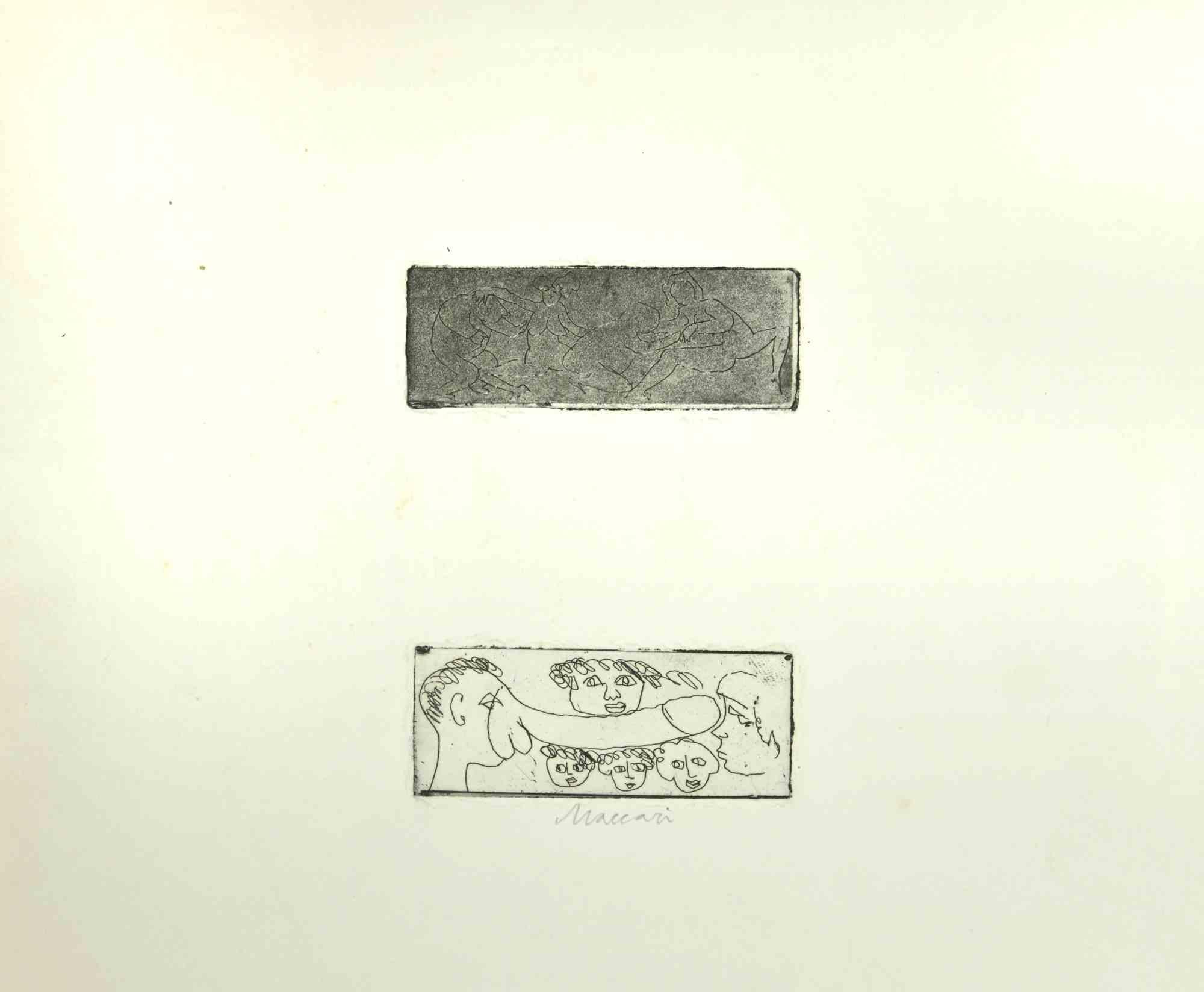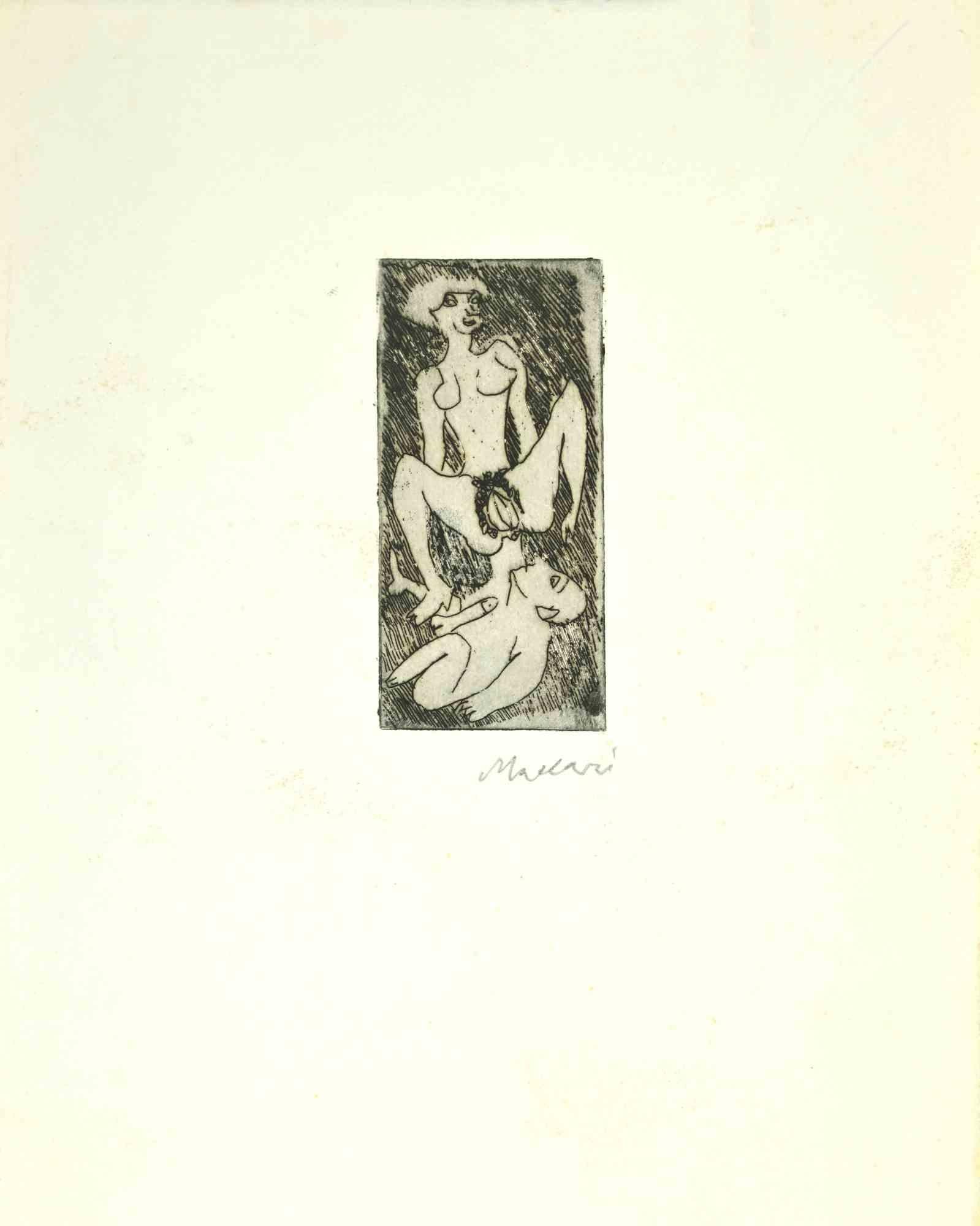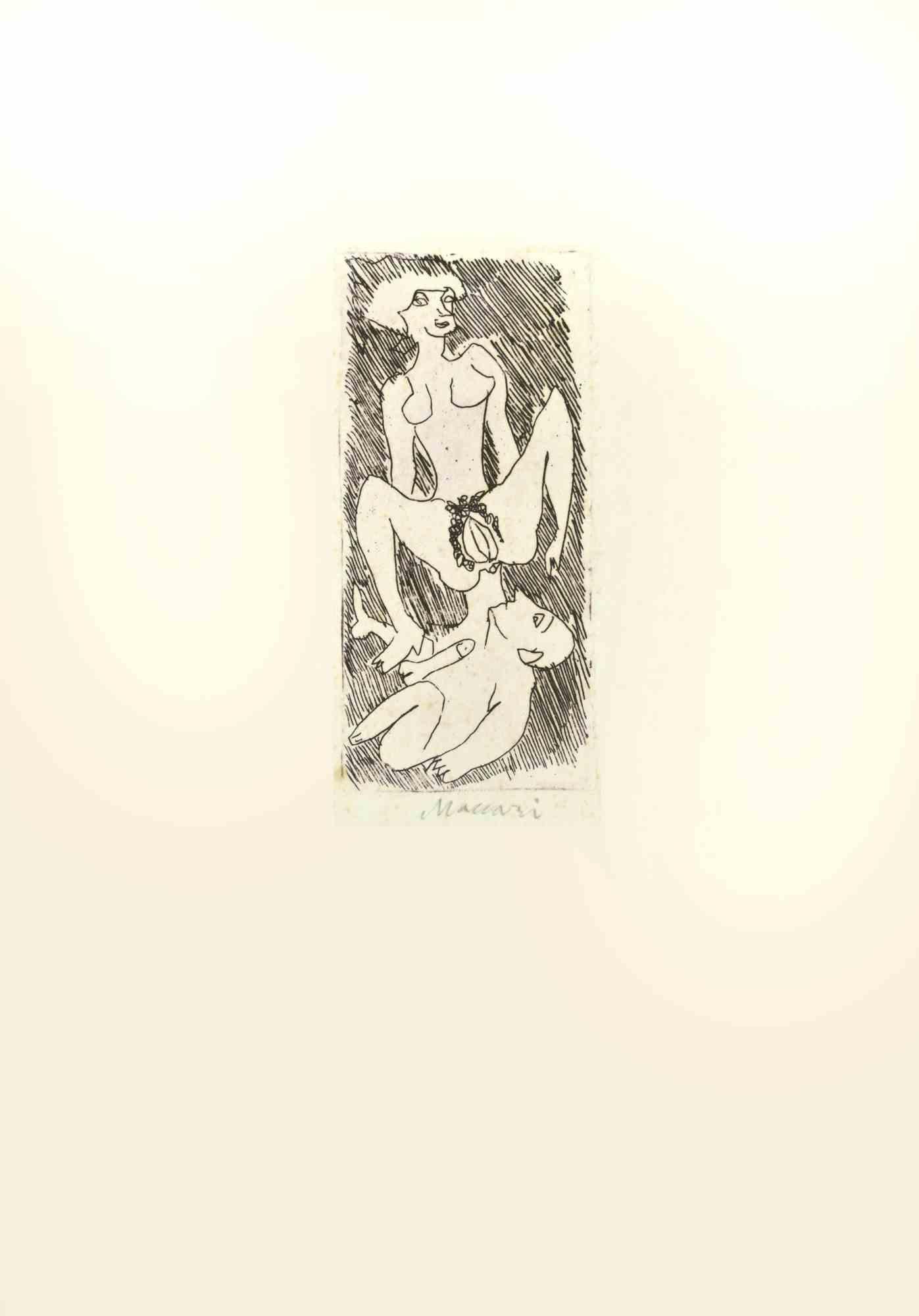Mino MaccariFigures - Drypoint by Mino Maccari - Mid-20th CenturyMid-20th Century
Mid-20th Century
About the Item
- Creator:Mino Maccari (1898 - 1989, Italian)
- Creation Year:Mid-20th Century
- Dimensions:Height: 13.78 in (35 cm)Width: 19.69 in (50 cm)Depth: 0.04 in (1 mm)
- Medium:
- Movement & Style:
- Period:
- Framing:Framing Options Available
- Condition:Insurance may be requested by customers as additional service, contact us for more information.
- Gallery Location:Roma, IT
- Reference Number:
Mino Maccari
Popular painter, engraver and journalist Mino Maccari is known for his often controversial and explosive prints, drawings and paintings, and is considered to be one of the most important Italian satirical artists of the 20th century.
Born in 1898 in Siena, Maccari joined the Italian Army at age 19 to serve in World War I as an artillery officer. Afterward, he attended law school, graduating in 1920 and working as a lawyer until 1926.
While working as a lawyer, Maccari developed an interest in painting and engraving, moonlighting as an artist. Despite his lack of formal training, his works captured the attention of local critics, and he debuted with the Group Labronico, an organization of like-minded Italian artists that included painter Beppe Guzzi.
In 1924, publisher Angiolo Bencini contacted Maccari to oversee the printing operations of Il Selvaggio, a fascist magazine in which Maccari’s first satirical illustrations and engravings appeared. Until 1942, Maccari was editor-in-chief of the controversial magazine, which featured contributions from Futurist artists such as Ardengo Soffici, Carlo Carrà and others.
Throughout his career, Maccari participated in numerous notable exhibitions and shows throughout Italy and Europe. His figurative drawings and paintings, portraits and exotic nude works gained considerable acclaim from critics and collaborative artists.
In 1927, he participated in the "Second International Exhibition of Modern Engraving" and the "Third Exhibition of the Tuscan Union of Arts." The following year, Maccari exhibited at the Venice Biennale, where he would win the International Prize for engraving in 1948.
From the late 1940s to 1963, Maccari collaborated with the liberal magazine Il Mondo, contributing several satirical illustrations and engravings. By this time, he had become a well-established and respected artist in Italy and, in 1959, was named director of the Academy of Fine Arts in Rome.
In 1963, Maccari was recognized again for his works, winning the Antonio Feltrinelli Prize for painting. That same year, he became president of the San Luca Academy.
Throughout the 1970s, Maccari continued painting and drawing, creating provocative works such as Dominatrix Woman, a bold work in watercolor and pastel, the diminutive pen drawing Trampled and his erotic charcoal and watercolor drawing Mata Hari.
Even after Maccari’s death in 1989, his works continue to be a talking point among avid modern art collectors.
Find original Mino Maccari drawings and watercolor paintings, prints and other art on 1stDibs.
- ShippingRetrieving quote...Ships From: Grasse, France
- Return PolicyA return for this item may be initiated within 14 days of delivery.
- Erotic Scene - Etching by Mino Maccari - Mid-20th CenturyBy Mino MaccariLocated in Roma, ITErotic Scene is an Etching and Drypoint realized by Mino Maccari in the Mid-20th Century. Hand-signed in the lower part. Good conditions. Mino Maccari (Siena, 1924-Rome, June 1...Category
Mid-20th Century Modern Figurative Prints
MaterialsPaper, Drypoint, Etching
- Erotic Scene - Etching by Mino Maccari - Mid-20th CenturyBy Mino MaccariLocated in Roma, ITErotic Scene is an Etching and Drypoint realized by Mino Maccari in the Mid-20th Century. Hand-signed in the lower part. Good conditions. Mino Maccari (Siena, 1924-Rome, June 16, ...Category
Mid-20th Century Modern Figurative Prints
MaterialsPaper, Etching, Drypoint
- Erotic Scene - Etching by Mino Maccari - Mid-20th CenturyBy Mino MaccariLocated in Roma, ITErotic Scene is an Etching and Drypoint realized by Mino Maccari in the Mid-20th Century. Hand-signed in the lower part. Good conditions. Mino Maccari (Siena, 1924-Rome, June 1...Category
Mid-20th Century Modern Figurative Prints
MaterialsDrypoint, Paper, Etching
- Faces - Etching by Mino Maccari - Mid-20th CenturyBy Mino MaccariLocated in Roma, ITFaces is an Etching and Drypoint realized by Mino Maccari in the Mid-20th Century. Hand-signed in the lower right part. Good conditions. Mino Maccari (Siena, 1924-Rome, June 1...Category
Mid-20th Century Modern Figurative Prints
MaterialsPaper, Drypoint, Etching
- Figures - Drypoint by Mino Maccari - Mid-20th CenturyBy Mino MaccariLocated in Roma, ITFigures is an Etching and Drypoint realized by Mino Maccari in the Mid-20th Century. Hand-signed in the lower right part. Good conditions. Mino Maccari (Siena, 1924-Rome, June ...Category
Mid-20th Century Modern Figurative Prints
MaterialsPaper, Drypoint, Etching
- Figures - Drypoint by Mino Maccari - Mid-20th CenturyBy Mino MaccariLocated in Roma, ITFigures is an Etching and Drypoint realized by Mino Maccari in the Mid-20th Century. Hand-signed in the lower right part. Numbered. Edition,3/40. Good conditions. Mino Maccari (Siena, 1924-Rome, June 16, 1989) was an Italian writer, painter, engraver and journalist, winner of the Feltrinelli Prize for Painting in 1963 and first winner of the Forte dei Marmi Satira Prize in 1973.After completing his secondary education, he enrolls in university. An interventionist like many young people of his time, he took part in the Great War at the age of nineteen as a field artillery officer. At the end of the conflict he resumed his university studies in Siena and in 1920 he graduated in law. In 1924 he was called by Angiolo Bencini to take care of the printing of the magazine Il Selvaggio, openly uncompromising fascist, revolutionary and anti-bourgeois, where his first engravings were published. After a few years of coexistence between work at the newspaper and the law firm, at the beginning of 1926 he left the legal profession to take over the direction of Il Selvaggio which he would hold until 1942. In 1928 he was the author of the small book published by Vallecchi (Florence), Il Trastullo di Strapaese (little songs and engraved woodwinds) which collected fascist songs (the same book was seized several times from Antonio Gramsci during his detention). With the transfer of the editorial staff of the Selvaggio in 1925 from Colle di Val d'Elsa to Florence, Maccari collaborated with Ardengo Soffici, Ottone Rosai and Achille Lega. In the meantime, between 1927 and 1930, he made himself known to the general public as a painter by participating in various national exhibitions. Also in 1930 Maccari works in Turin at La Stampa as editor-in-chief and has the writer Curzio Malaparte as director. His presence in the cultural and editorial world of the fascist regime is very intense, he writes and collaborates with various magazines: Quadrivio, L'Italia Letteraria, L'Italiano and Omnibus by Leo Longanesi; then, during the war, in il Primato di Bottai and, subsequently again, in Il Mondo di Pannunzio (from the first number, in 1949), up to Documento by Federigo Valli. His graphic production is also vast, ranging from the Album of Vallecchi (1925), Il trastullo di Strapaese (1928) to Linoleum (1931). Maccari illustrated in 1934 La vecchia del Bal Bullier by Antonio Baldini and in 1942 he published the Album folder, followed by Come quando fuori Piove and Il superfluo illustrata.For his pictorial work full of evident chromatic accentuations and fast brushstrokes, the violent drawing combined with the lively stroke of the graphic sign of his engravings, he is recognized by critics as a complete artist. In 1962 he was also entrusted with the presidency of the Accademia di San Luca in Rome and managed to obtain a personal exhibition at Gallery 63 in New York. His production of drawings, watercolors, temperas, etc. is endless, sometimes in collaboration with prestigious publishing houses; it is worth mentioning, just as an excellent example, the 32 b/w and color drawings with which he illustrated Il gusto di vivere, a volume that collects writings by Giancarlo Fusco, edited by Natalia Aspesi and published by Laterza in 1985. Maccari, Sienese and great contradaiolo della Torre, painted the Palio...Category
Mid-20th Century Modern Figurative Prints
MaterialsPaper, Drypoint, Etching
- Spring Song /// Antique Female Artist Children Child Etching British ArtBy Eileen SoperLocated in Saint Augustine, FLArtist: Eileen Alice Soper (English, 1905-1990) Title: "Spring Song" *Signed by Soper in pencil lower right Year: 1924 Medium: Original Etching on cream laid paper Limited edition: 178 Printer: Likely printed by Eva Soper, London, UK Publisher: H C Dickens, London, UK Reference: "The Catalogue Raisonne of Prints and Etchings of George and Eileen Soper" - Beetles No. 83, page 119, 141, 157 Sheet size: 8.13" x 10.13" Image size: 6.63" x 9.63" Condition: Paper trimmed in the margins. A few faint areas of discoloration. It is otherwise a strong impression in very good condition Notes: Provenance: private collection - Boulder, CO. Biography: Eileen Soper was born in 1905 in the Municipal Borough of Enfield and moved to the house where she was to spend the rest of her life in Harmer Green, Welwyn in the Hertfordshire countryside in 1908. The house she later named "Wildings" was built by her father, the artist George Soper...Category
1920s Modern Figurative Prints
MaterialsIntaglio, Drypoint, Laid Paper, Etching
- Low Country (South Carolina)By Elizabeth VernerLocated in Middletown, NYAn enchanting Southern landscape by the mother of the Charleston Renaissance. A native of Charleston, South Carolina, and educated under the tutelage of Thomas Anshutz at The Pennsylvania Academy of Fine Arts, O'Neill Verner was a teacher, a mother, an artist, an ardent preservationist, and a skilled autodidact. Having previously focused on painting, in the early 1920s she found herself deeply moved by printmaking as a media, and especially so by the simple, peaceful themes and tableaus she discovered in Japanese art. She embarked on a effort to teach herself Japanese printmaking techniques, and in the process, produced the charming images of every day life in Charleston and its environs that earned her recognition as a cultural icon in her day, and in more modern times, as the mother of the Charleston Renaissance, which flourished well into the 1930s. In 1923 she opened a studio in Charleston where she focused on documenting the local color and the architecture and landscape that distinguishes Charleston as one of the South's most beautiful cities, all the while applying the gentle and poetic thematic sensibilities of Japanese printmaking. O'Neill Verner soon found herself in high demand when municipalities and institutions throughout the country sought commissions from her to document the beauty of their grounds and historic buildings. She worked as far north as the campuses of Harvard and Princeton, and extensively across the South, including in Savannah, Georgia, where through sweeping commissions she was able to marry her love of southern preservation and art. O'Neill Verner was a lifelong learner, and continued a path of edification that led her to study etching at the Central School of Art in London, to travel extensively through Europe, and to visit Japan in 1937, where she studied sumi (brush and ink) painting. She was a founding member of the Charleston Etchers Club, and the Southern States Art League. Her works are represented in the permanent collections of leading museums across the American south, and in major national institutions including the Metropolitan Museum of Art, Boston's Museum of Fine Art, and the Smithsonian American Art Museum. O'Neil Verner...Category
Early 20th Century American Modern Landscape Prints
MaterialsArchival Paper, Drypoint, Etching
- The SmithyBy Sir David Young Cameron, R.A.Located in Middletown, NYA warm composition, in theme and tone; the creaky timber interior of a 19th century Scottish blacksmith's shop. Etching and drypoint on cream laid Japan paper, 8 x 10 inches (202 x ...Category
Late 20th Century Modern Interior Prints
MaterialsDrypoint, Laid Paper, Etching
- The Acropolis, AthensBy Louis Conrad RosenbergLocated in Middletown, NYEtching and drypoint on cream wove paper, full margins. Signed in pencil, lower right margin. In generally good conditon with several scattered very light spots of foxing throughout,...Category
1920s Modern Landscape Prints
MaterialsHandmade Paper, Drypoint, Etching
- Ponte della Trinità, FlorenceBy David Young CameronLocated in Middletown, NYEtching and drypoint on tissue-thin cream laid paper, 6 5/8 x 8 1/8 inches (167 x 205 mm), full margins. Signed in pencil in the lower right margin, and inscribed "Ponte Trinità, Flo...Category
Early 20th Century Modern Landscape Prints
MaterialsLaid Paper, Drypoint, Etching
- Tugs on the HudsonBy Charles Frederick William MielatzLocated in Middletown, NYDrypoint etching with engraving printed in black ink on Japanese mulberry paper, 4 1/2 x 3 3/8 inches (113 x 84 mm), full margins. In superb condition. A beautiful New York City rive...Category
Early 20th Century American Modern Landscape Prints
MaterialsHandmade Paper, Drypoint, Etching
